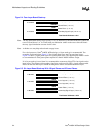
Motherboard Layout and Routing Guidelines
2-4
Intel
®
440GX AGPset Design Guide
Note: The top and bottom routing layers specify 1/2 oz. cu. However, by the time the board is plated, the
traces will end about 1 oz. cu. Check with your fabrication vendor on the exact value and insure
that any signal simulation accounts for this value.
Note: A thicker core may help reduce board warpage issues.
For a dual processor / Intel
®
440GX AGPset design, a 6 layer stack-up is recommended. Two
examples are shown below. Figure 2-5 has 4 signal plane layers and 2 power plane layers.
Figure 2-6 shows 3 signal plane layers and 3 power plane layers. The second option makes it easier
to accommodate all of the power planes required in a Intel
®
440GX AGPset design.
If a 6 layer stack-up is used, then it is recommended to route most of the GTL+ bus signals on the
inner layers. The primary and secondary signal layer can be used for GTL+ signals where needed.
Routes on the two inner layers should be orthogonal to reduce crosstalk between the layers.
Figure 2-4. Four Layer Board Stack-up
Primary Signal Layer (1/2 oz. cu.)
Ground Plane (1 oz. cu.)
Power Plane (1 oz. cu)
Secondary Signal Layer (1/2 oz. cu)
5 mils
47 mils
5 mils
PREPREG
CORE
PREPREG
Z = 60 ohms
Z = 60 ohms
Total board thickness = 62.6
Figure 2-5. Six Layer Board Stack-up With 4 Signal Planes and 2 Power Planes
Primary Signal Layer (1/2 oz. cu.)
Ground Plane (1 oz. cu.)
Inner Layer #1 (1 oz. cu.)
Inner Layer #2 (1 oz. cu)
Power Plane (1 oz. cu)
Secondary Signal Layer (1/2 oz. cu)
6 mils
18 mils
6 mils
18 mils
6 mils
PREPREG
PREPREG
PREPREG
CORE
CORE
Z = 66 ohms
Z = 73 ohms
Z = 66 ohms
Total board thickness = 62.4


















